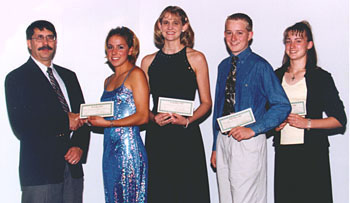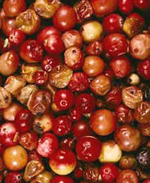Recently four high school students were rewarded for all their hard work by the American Phytopathological Society (APS)
in the 51st Intel International Science and Engineering Fair, held May 7-12 in Detroit, MI. These four students were part of the approximately 1,200 young scientists who presented the results of their research. All were competing for prizes and scholarships from numerous organizations.
 |
| Andrew Jarosz with ISEF winners (from left to right), Milena Pastore, Helen Wiersma, Tyler Jorgenson, and Sara Jo Weirather |
APS was represented by Annemiek C. Schilder, Jerri M. Gillett, Andrew M. Jarosz, and Anita L. Davelos of the Department of Botany and Plant Pathology at Michigan State University, East Lansing, MI. The APS judges viewed hundreds of displays in botany, environmental science, and microbiology to evaluate their relevance to plant pathology. The pool was narrowed down to fifteen projects which were then judged on creativity, scientific thought, thoroughness, skill and clarity. A high value was given for originality and evidence that the students had significant input on the ideas for the project and the experimental design. Four of the fifteen students were awarded prizes:
- First Place ($500)—Milena Evangelina Pastore, age 16, a sophomore at Monte Vista High School, Monte Vista, CO, for "Welcome to the Collembola Café" (environmental science category). She evaluated the fungivorous habits of Collembola as a potential biological control agent of potato pathogens that inhabit the soil for all or part of their life cycles.
- Second Place ($350)—Helen Irene Wiersma, age 18, a senior at Okeechobee High School, Okeechobee, FL, for "Pathogenic Control of Tropical Soda Apples" (botany category), on the pathogenicity of Erwinia carotovora on tropical soda apple (Solanum viarum). Wiersma evaluated whether E. carotovora can improve control of soda apples by killing the rootstocks that remain after treatment with herbicides. Helen won second place last year also.
- Third Place ($250)—Tyler Lee Jorgenson, age 14, a freshman at Buena High School, Sierra Vista, AZ, for "Tropical Flavored Fungi," in which he described the effect of various tropical house-plants on fungal growth in culture (microbiology category).
- Fourth Place ($100)—Sara Jo Weirather, age 15, a freshman at Central Lee High School, Donnellson, IA, for "Growth Regulators of Agrobacterium tumefaciens" (microbiology category). Weirather studied the effects of A. radiobacter strain 84 and vitamin E on gall formation in sunflower and tomato plants.
Jarosz presented the awards on behalf of APS, and each winner received a check, a framed certificate, and an APS T-shirt. The APS judges were very impressed by the creativity and level of understanding of the scientific method displayed by the participants.
So, teachers, if you are trying to get students involved in science fairs, show them that their hard work can be rewarded like the four students mentioned above. Perhaps your students could find their way to the next Intel International Science and Engineering Fair.
 |
Views: Cranberries are subject to a number of diseases, and berry rots are of particular importance. You can read more about the origin of cranberries, how they are grown, and their disease problems in this month's APSnet Feature Article: "Cranberries: The Most Intriguing Native North American Fruit." For more interesting facts about the fungi that must be overcome to enjoy a traditional Thanksgiving dinner, visit Tom Volk's Fungi Website.
|
